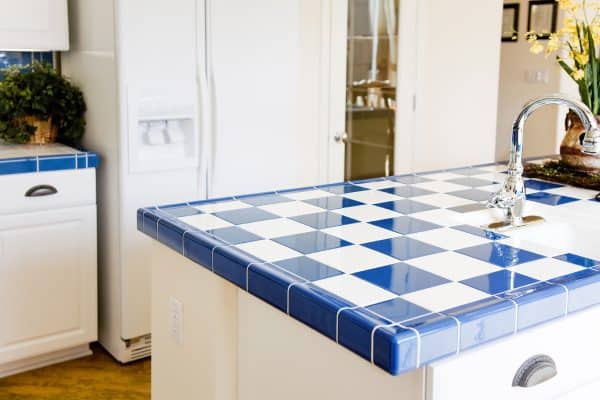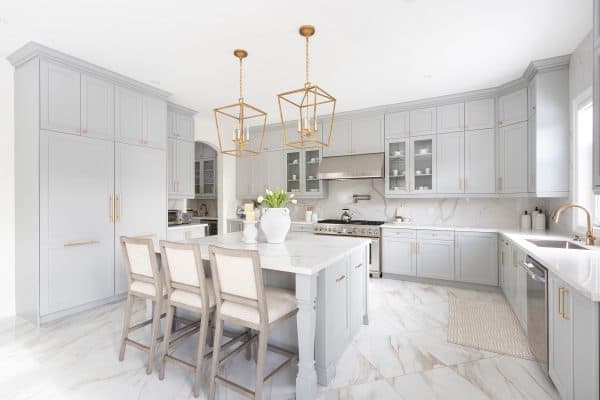Nothing screams classic elegance quite like a circular floor tile pattern. They literally "round" up a room, creating an illusion of a wider area, and balancing the layout so that it is one integrated space. There are many floor patterns that can emphasize the room's innate classic style, so it can be challenging to stick with a particular design.
Vintage designs have richer and bolder patterns. They can be visually overwhelming, but it's not an issue if that's what you're going for. Some patterns can create an optical illusion, while others bring out the effortless beauty of the space.
However, there are also designs that are made to work with the room's interior and color palette.
The pattern is not the attraction itself; it integrates into the space and makes it look wider and aesthetically pleasing. These designs are generally preferred in most homes that are looking to increase their value and visual appeal.
We have gathered 11 ideas that will inspire you to install a circular tile floor pattern. Read below to learn more!
![A decorative circular floor tiles, Circular Floor Tile Patterns [11 Gorgeous Ideas!]](https://houseunderfoot.com/wp-content/uploads/2022/08/Circular-Floor-Tile-Patterns.png)
1. Detailed but Simple
Circular tile floor patterns are usually found in bigger, more opulent living rooms, but that doesn't mean it's impossible to put into more conservative living areas. This pattern gives the living room an effortless visual appeal, and it grounds the room's elements together to create a cohesive design.
The colors also complement the floors and furniture, so it blends seamlessly into the interior. If you want a more detailed pattern, make sure it matches the atmosphere of the room is it won't look lost. If possible, complement the pattern in the tiles with other elements in the room, such as couch or carpet patterns.
2. Minimalist Design
If you want a toned-down approach without losing the elegance that a round tile pattern offers, opt for a minimalist circular pattern. Emphasize a piece of furniture or an area in your house so that the floors are not the only attention-grabbing element in the room.
Make the pattern work for the room instead of the other way around. Make sure that the colors camouflage with the interior for a cohesive design.
3. Soft-Angled Designs
If you want a rich pattern that is not overly detailed, soft-angled designs could be for you. The swirls will give off a good amount of visual stimulation, but the pattern is not too complicated as to hoard all the attention.
Soft angles are also easier to look at. They are not visually overwhelming, and they tie a room together. Make sure that the colors remain cohesive with the interior by matching the trims with the pattern.
4. Sharp and attention-grabbing
[/PIN]
If your goal is to make the floor pattern as magnetic as possible, opt for a pattern that has sharp details and deep color.
This will make your space more unique, and it will add character to the room. Since you want it to have sharp details, make sure that the pattern colors won't clash with your color scheme. The floor pattern should still be well-integrated with the room, and it should remain cohesive for aesthetic purposes.
Read: "Should Curtains Match Carpet Or Walls?"
5. Optical Play
Checkered floors are notorious for their optical illusion. Although they can be visually overwhelming, they are a classic and tried-and-true design that you can go for if you want an elegant but unique area.
Checkered floors are best paired with neutral-colored walls so that the play of colors won't be dizzying. If possible, try to install the pattern in a recreational room instead of a work area to avoid tired eyes.
Pair a checkered floor with stark white walls so the room remains bright even with the rich pattern on the floor. If you want a gothic look, paint the walls with a darker neutral color.
6. Whimsical and Artistic
Circular patterns don't have to strictly be round in shape. Go for a star-shaped pattern if you want a more whimsical flair and paint with warm and vibrant colors to make the space feel more welcoming. Round tile patterns tend to be intimidating, so this design is a more friendly alternative to that.
This pattern is ideal for curved walls as the sharp angles provide visual contrast against the curved layout of the room. It gives more structure, but the appealing design gives an air of lightness and creativity.
7. Subtle and Classy
Sometimes, less is more--and this design proves it! Elegant interiors start with incorporating subtle designs that give the room dimension and texture without being visually overwhelming. They are more aesthetically versatile, so you won't have to worry about decorations being out of place.
You will have more freedom to explore other styles since you won't have a vibrant pattern on the floor to consider, but the floor design will always be there to provide visual appeal.
This pattern is ideal if you don't want to commit to a singular design but still want the grounding character of circular tile patterns and if you only want a clean, polished look in your area.
8. Black and White
You can't go wrong with a classic black and white design. It goes with any interior design and color scheme and has an effortless, elegant appeal regardless of your space's size.
If you have a smaller space, utilize the neutral shades by going for wide geometric shapes that won't crowd a room. For larger spaces, give the design more details to ground the room to the center.
Black and white designs are ideal if you want to stick to the safe route and don't want vibrant colors hoarding the attention. However, it is best to emphasize the pattern especially if there are few decorations and elements in the room.
9. Statement Design
Although minimal details are sometimes a breath of fresh air, there's nothing like a statement design that could elevate the room's look.
Build an intriguing pattern on the floor for visual appeal and make the furniture and decorations work around it, and make sure it remains cohesive with the room's color scheme.
Circular statement designs are best placed in a wide, curved room so that the eyes will instantly be trained at the center. You can do this in function rooms, living areas, or recreational rooms if you want uniqueness.
10. Richly Detailed
Showcase opulence by going for a richly-detailed floor pattern. This is ideal for large spaces with high ceilings that can emphasize the floor pattern without making the space seem crowded.
It is best to go for neutral shades in your interior if you want a rich pattern on the floor so everything will remain visually cohesive even if you change your furniture and decorations.
Try not to obstruct the pattern with heavy furniture. Instead, make the room design work around the floor pattern.
11. Structured and Geometric
Give a large room some structure and character by creating structured patterns on the floor. This will instantly provide visual stimulation and character, making the space more unique.
Make sure you have enough space to create a grounding pattern and don't obstruct it with large furniture that can make the area look cramped. This pattern can be applied in all room layouts as long as it is wide enough, unlike others that can only work with a curve-shaped room.
Make sure that the center of the chandelier is parallel to the circular pattern so the room won't feel skewed. Remember that balance is everything when creating a circular floor pattern.
Final Thoughts
The key to creating a visually appealing floor pattern is to make the room feel balanced and structured. The designs you choose should make the room grounded and integrated together, and they should fit your preferences and personal aesthetic.
Choosing the right pattern can be challenging, but having a clear vision of what you want can narrow your options. Above all, make sure to prioritize the mood that the space evokes and let the tile patterns blend with that.
Want to learn more about tile installation, read: "How To Tile A Mudroom Floor."



